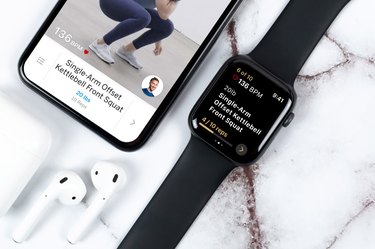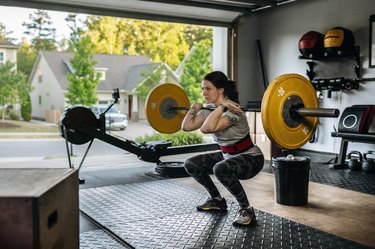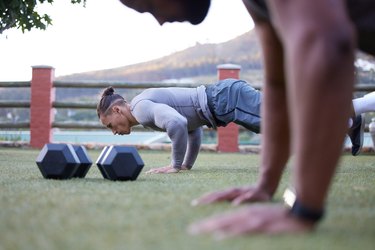I'll be honest: Ever since the start of the COVID-19 pandemic, my exercise motivation hasn't been what it used to be.
Not only was my CrossFit gym — where I'd work out about four days a week — closed temporarily due to my state's lockdown restrictions, but the general stress of living through a pandemic sapped my desire to do much more than go on a few socially distanced walks each week.
Video of the Day
Video of the Day
Once I went back to my gym about seven months later in October 2020, I struggled with getting back into my previous routine. I felt like a totally different person, having to force myself to make it to two — or three if I was lucky — classes per week.
While I typically make it to three CrossFit classes per week now and go for long walks or short runs on my off days, I wanted to up the ante with a goal of getting a more intense workout in five to six days a week.
Enter: Future, an app that matches you with a personal trainer who creates a workout program based on your goals and their knowledge.
What Is the Future App and How Does It Work?
Future is a virtual personal training app where a coach programs weekly workouts for you and checks in with you multiple times a week. A membership costs $150 per month.
Upon downloading the app (iOS, $150), which is only available from the Apple store at the moment, I was prompted to fill out a questionnaire about myself, my goals, what types of activities I already do, what exercise equipment I had access to and what I wanted in a coach (high energy, drill sergeant, someone with a background in nutrition, etc.).
Next, I was given a choice of four coaches the app thought were good matches, with one coach marked as a "best fit." After reading through everyone's bios, interests and coaching styles, I went with the person who the app suggested would be my best match: Sarah Gascon, PhD, a performance coach with a doctorate in kinesiology.
Sarah and I had an introductory FaceTime call to get to know each other. We not only talked about my exercise history, current fitness level and goals, but also about our lives and interests outside of the gym. Despite only knowing her for 30 minutes, I felt like I'd known her for years: Her high energy and positivity made her extremely easy to talk to, and I immediately felt like she'd be in my corner throughout this process.
Plus, I liked her coaching style and approach to fitness. For instance, she mentioned how she was flexible with her programming — if you didn't get much sleep one night and felt too exhausted for the full-body HIIT workout scheduled that day, she'd program a rest day or a more manageable workout for your energy levels instead. I'm also a big proponent of listening to your body and allowing for some flexibility in a workout plan, so I knew this was a good match.
What Are the Workouts Like?
Because everyone has different goals and fitness levels, no two people's workout programs look exactly the same. Sarah programmed my weekly workouts knowing I do CrossFit three days a week and that I want to get my cardio fitness up and do more yoga. Each week looks a little something like this:
- Monday: CrossFit class
- Tuesday: CrossFit class
- Wednesday: CrossFit class
- Thursday: Rest day
- Friday: Full-body strength workout, programmed by Sarah
- Saturday: Yoga and/or Pilates, programmed by Sarah
- Sunday: Full-body HIIT/plyometric workout, programmed by Sarah
You can follow along with the workouts in the app on your phone, but because I was doing Sarah's programmed workouts in my living room, I found it helpful to AirPlay them from my phone to my smart TV because the screen is bigger.
Each of my training sessions started with a warm-up to get my heart rate up. Then the workouts began. They typically consisted of two to three circuits with two to three rounds each and 20 to 30 seconds of recovery between each exercise. Last came a cooldown, which usually included stretching.
On the screen, a trainer demonstrated the moves and narrated how to do them. On some moves, Sarah's voice came through with other tips she wanted me to keep in mind. (You can also record yourself doing the exercises and send them to your coach to make sure your form is correct.) The equipment needed and number of reps (or time) was always listed on the screen as well.
All of your daily activity (not just the programmed workouts from your coach) integrates with your Apple Watch — Future sends you one to use throughout the duration of your membership if you don't already have one at no extra cost — so you and your coach can keep track of your heart rate, calories burned, steps and other metrics.
What I Liked About It
- You can choose what music plays in the background of your workout from preloaded playlists on the app (classic rock, throwback rap, current hits, calming music, etc.).
- The app narrates how to do the exercise in addition to showing you a trainer demo, and your coach sometimes voice records other tips they want you to keep in mind while doing the move.
- You can record your form for your coach to see.
- Your coach checks in regularly with you to see how you're doing, how you feel, if you're hydrating enough and even just to chat about.
- There's a chat feature that functions like instant messaging. You can message your coach with any questions, concerns or feedback you have. (Note: Some coaches may not be in your time zone, so they may not see your message right away.)
- You can do the workouts anytime during the assigned day, so there's a ton of flexibility depending on your schedule (as opposed to meeting with a trainer for an in-person session at a set time).
Potential Drawbacks
- The cost — $150 per month may not be possible for everyone's budget. However, the average cost per month for a personal trainer is about $250 to $400 for two sessions per week, so Future is cheaper in comparison.
- It's only available for iPhones at the moment, but Android support is in the works.
- The trainers who demo the moves for you on screen aren't size-inclusive.
So, Should You Try It?
If you're looking for personal training with a ton of flexibility and/or you struggle with motivation, this app is for you. Depending on your schedule, finding a set time to work out with a personal trainer in real life may be hard, and this app lets you do the planned workout at any time during the day. Plus, the fact that your coach will know if you didn't do your scheduled workout keeps you accountable.
Additionally, each exercise in your workout is demonstrated and narrated by a trainer and/or your coach. That means there's no confusion and less risk for injury due to your form being off.
While you may experience sticker shock when seeing the $150-per-month membership price, it is cheaper than the average monthly personal training cost — especially if you live in a major city. Plus, you can get your first month of training with Future for only $19. (And if you give it a try and you're not a fan, you can cancel at any time with a 30-day money back guarantee.)
If Future isn't in your budget, you may be better served seeking out cheaper personal training options, joining a less expensive gym or following workouts on YouTube or other free fitness apps.
Begin Your Fitness Journey With Future
Get your first month of training for only $19 (and Future has a 30-day money back guarantee).
Join now: Future.co; Price: $19/month for the first month, then $150/month



